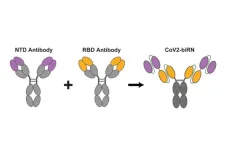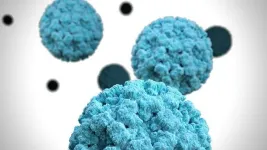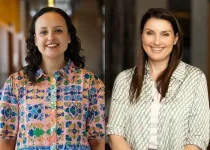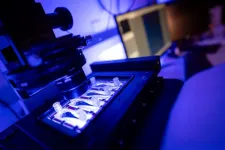For the first time, Northwestern University scientists have watched water molecules in real-time as they prepared to give up electrons to form oxygen.
In the crucial moment before producing oxygen, the water molecules performed an unexpected trick: They flipped.
Because these acrobatics are energy intensive, the observations help explain why water splitting uses more energy than theoretical calculations suggest. The findings also could lead to new insights into increasing the efficiency of water splitting, a process that holds promise for generating clean hydrogen fuel and for producing breathable oxygen during future missions to Mars.
The study will be published Wednesday (March 5) in the journal Science Advances.
“When you split water, two half-reactions occur,” said Northwestern’s Franz Geiger, who led the study. “One half-reaction produces hydrogen and the other produces oxygen. The half-reaction that produces oxygen is really difficult to perform because everything has to be aligned just right. It ends up taking more energy than theoretically calculated. If you do the math, it should require 1.23 volts. But, in reality, it requires more like 1.5 or 1.6 volts. Providing that extra voltage costs money, and that’s why water splitting hasn’t been implemented at a large scale. We argue that the energy required to flip the water is a significant contributor to needing this extra energy. By designing new catalysts that make water flipping easier, we could make water splitting more practical and cost-effective.”
Geiger is the Charles E. and Emma H. Morrison Professor of Chemistry at Northwestern’s Weinberg College of Arts and Sciences and member of the International Institute for Nanotechnology and the Paula M. Trienens Institute for Energy and Sustainability. The study’s coauthors are Northwestern’s Raiden Speelman and Ezra J. Marker, who are both members of Geiger’s lab.
Water splitting’s promise and challenges
As the climate continues to warm, researchers have become increasingly interested in water splitting as a way to produce clean hydrogen fuels as an alternative to fossil fuels. To perform the process, scientists add water to a metallic electrode and then apply a voltage. This electricity splits water molecules into two components — hydrogen and oxygen — without any unwanted byproducts. From there, researchers can collect hydrogen for fuel or repurpose the hydrogen and oxygen into energy-efficient fuel cells.
While water splitting could play a significant role in a future clean-energy economy, it faces several challenges. The main issue is that the oxygen part of the reaction, called the oxygen evolution reaction (OER), can be difficult and inefficient. Although it's most efficient when iridium is used as the electrode, Geiger said scientists need more affordable alternatives.
“Iridium only comes to Earth from meteoric impacts, so there’s a limited amount,” he said. “It’s very expensive and certainly not going to help solve the energy crisis any time soon. Researchers are looking at alternatives, like nickel and iron, and we’re hoping to find ways to make these materials just as efficient — if not more efficient — than iridium.”
‘Optical equivalent to noise-canceling headphones’
To understand why some catalysts are better than others, Geiger’s team wanted to watch the OER process in action. To gain this unprecedented glimpse, his team developed a sophisticated new technique to observe how water molecules interact with the metallic electrode in real time.
First, they added an electrode and the water to a special container. Then, they shined a laser onto the electrode’s surface and measured the light intensity at half the wavelength. Called second harmonic generation, the process is like listening for the first overtone of a tuning fork when hitting it a bit harder than usually. But, using multiple optical components — lenses, mirrors and crystals — the researchers manipulated the laser beam to gain more information.
“Our technique is the optical equivalent to noise-canceling headphones,” Geiger said. “We can essentially control constructive and deconstructive interference — the photon's phase — and, from that, we can precisely quantify how many water molecules are pointing to the surface and how many rearrange to point in away from it.”
By analyzing the amplitude and phase of the signal photons, Geiger’s team gained information about how the water molecules were arranged. Before applying the voltage, the researchers noticed the water molecules were randomly positioned. As they applied a precise voltage to the electrode, however, they watched the water molecules reorient themselves.
Flipping water on its ‘head’
Water molecules look like a simplified drawing of Mickey Mouse — with a large oxygen atom as the “head” and two smaller hydrogen atoms as the “ears.” Initially, the hydrogen “ears” touch the nickel electrode. But the applied voltage caused the molecules to flip, so the oxygen “head” touched the electrode, ready to give up its electrons.
“Electrodes are negatively charged, so the water molecule wants to put its positively charged hydrogen atoms toward the electrode’s surface,” Geiger said. “In that position electron transfer from water's oxygen atom to the electrode's active site is blocked. When the electric field becomes strong enough, it causes the molecules to flip, so the oxygen atoms point toward the electrode’s surface. Then, the hydrogen atoms are out of the way, and the electrons can move from water's oxygen to the electrode.”
By directly observing the water molecules flip, the researchers were able to measure how many water molecules flipped as well as the energy associated with that flipping. They found the flipping happens immediately before OER starts, indicating this is a necessary, non-negotiable step in the process. They also found the water’s pH level influences the orientation of water molecules. Higher pH levels, for example, made the process more efficient.
Insights into water’s mysterious nature
While this new window into the behavior of water molecules could lead to more efficient catalysts for water splitting, it also could help researchers better understand other electrochemical processes for energy storage and energy-conversion technologies.
Geiger said his team’s new technique also could help shed new insights into the mysterious nature of water.
“Our work underscores how little we know about water at interfaces,” he said. “A classic curiosity is the melting anomaly. When you freeze a liquid, it becomes denser, meaning the frozen matter should fall to the bottom of a container. Almost all liquids do this. But when water freezes, its density actually decreases. That’s why we see ice floating on top of Lake Michigan. Water is tricky, and our new technology could help us understand it a bit better.”
The study, “Quantifying stern layer water alignment before and during the oxygen evolution reaction,” was supported by the U.S. National Science Foundation (grant number CHE-2153191), the Air Force Office of Scientific Research (grant number FA9550-16-1-0379), the U.S. Department of Energy (grant number DE-SC0023342) and Army Research Office/Defense Advanced Research Program Agency (grant number W911NF1910361/75506-CH-DRP).
END






